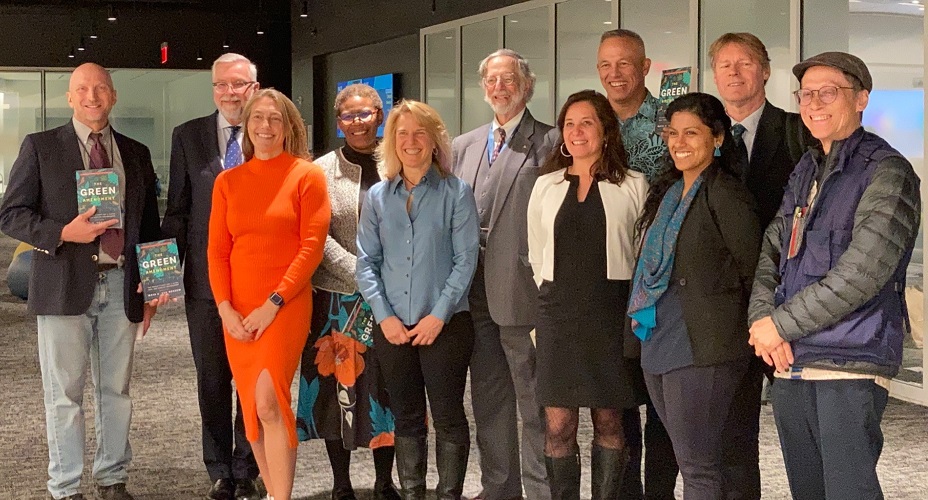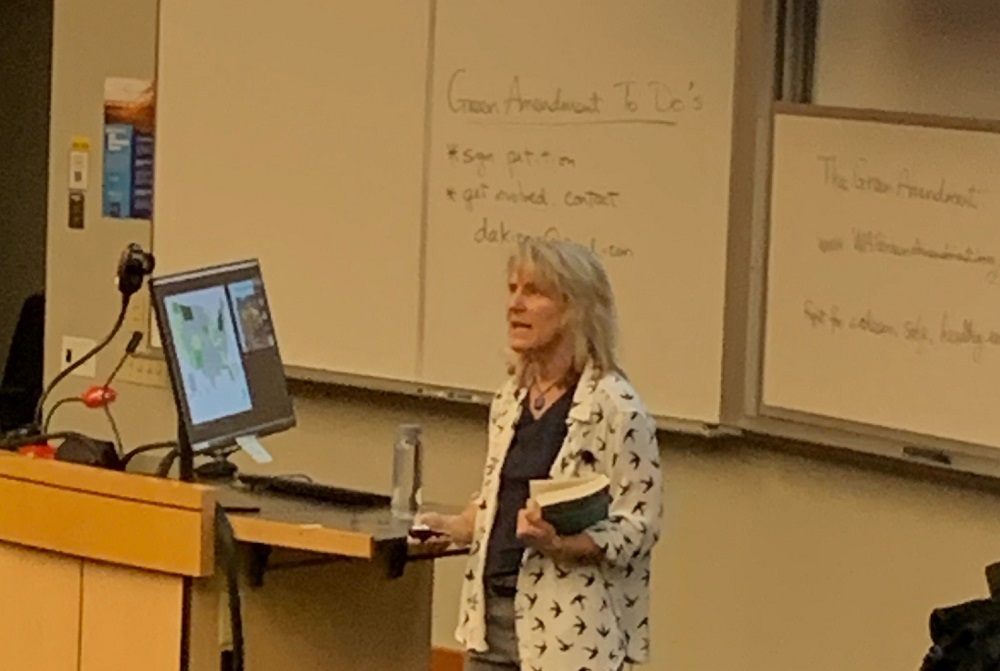First Decision Applying New York’s Green Amendment Already Demonstrating Its Value & Setting Strong Precedent
On December 7, 2022, Fresh Air For The Eastside v. the State of New York, et. al, the Supreme Court of New York, the trial court level in New York State, issued the first decision based on the New York Green Amendment since it was added to the state’s constitutional Bill of Rights. In this ruling, the Court offered important points clarifying the meaning of the amendment.
The case was brought by neighbors of a landfill. The legal arguments focused on emissions from the landfill, including greenhouse gas and noxious odor emissions, and challenged the state environmental agency’s failure to prevent a violation of the Green Amendment, the constitutional right to clean water and air, and a healthful environment, of neighbors to the landfill.
In its decision refusing the state’s request that the action be dismissed, the court made a few critical legal determinations regarding New Yorker’s newly secured environmental rights. According to the Court’s decision:
- The New York Green Amendment is self-executing and requires no additional legislation to be enforceable.
- The New York Green Amendment is enforceable against government action and not intended to be used in direct actions against private parties.
- The New York Green Amendment is enforceable against government action and omissions/inaction when they result in a constitutional environmental rights violation.
- Filing with the court to make a claim of a constitutional violation of Article 1 Section 19 and the environmental rights it protects, is appropriate, and plaintiffs are not required to exhaust administrative remedies before invoking the court’s jurisdiction;
- It is appropriate for a court to grant declaratory relief (i.e. a judgment that constitutional rights have been violated and must be remedied) in response to a claim that constitutional environmental rights recognized in Article 1 Section 19 (i.e. the New York Green Amendment) have been violated.
- “Complying with the constitution is not optional for state agencies.”
- The state lacks discretion to violate the Constitution, thus the court has the ability to compel the state to comply with the New York Green Amendment when a violation has been found.
Notably, the court characterized the New York amendment as a Green Amendment, a term coined in the 2017 book titled The Green Amendment, which identifies the criteria necessary for giving environmental rights highest constitutional protection and standing. The book was authored by Green Amendments founder, Maya van Rossum, who also joined as a leader in securing Article 1 Section 19, passed in 2021, and ensures the right of all New Yorkers to clean water and air, and a healthful environment – i.e. New York’s Green Amendment.
“This decision demonstrates the power and importance of recognizing the inalienable rights of all New Yorkers to clean water and air, and a healthful environment. But for the constitutionally recognized right, the Eastside community would appear to have no remedy for being overwhelmed by the air contamination emanating from the landfill, including the knowledge that greenhouse gas emissions released from the landfill were contributing to the climate crisis and the very direct and real ramifications climate change is inflicting on New York communities,” stated Maya van Rossum. “This victory is also demonstrating how Green Amendments can be helpful for environmental protection nationwide.”
Experts Help New Yorkers Get Up To Speed on their NY Green Amendment
Green Amendments For The Generations teamed up with our lead partners in New York state to hold a training on how the newly passed NY Green Amendment could be used to advance environmental protection and environmental justice. In a Q&A style discussion led by Kate Kurera of Environmental Advocates For New York, Green Amendments Founder Maya van Rossum, Anthony Rogers-Wright of New York Lawyers for the Public Interest, Michael Youhana of EarthJustice, and Professor Rebecca Bratspies of CUNY School of Law, highlighted the unique elements of New York’s Green Amendment language, how it interacts with existing law, and how it can help address loopholes and deficiencies in the law. The values of the amendment for both activism and litigation were explored.
Don’t worry if you missed it, you can view a recording of the program here.
Word Continues to Spread Nationwide
Interest in the Green Amendment concept and the new book continues to spread. In the past 6 weeks:
The Green Amendment book launched. In a room filled with international dignitaries protecting environmental rights around the world, Maya van Rossum joined international environmental law expert Nicholas Robinson, to discuss the Green Amendment movement and to announce release of her new book The Green Amendment, the People’s Right To a Clean Safe and Healthy Environment. The following people were part of this robust and engaging conversation:
- Internationally recognized Environmental Law expert Nicholas A. Robinson, advancing environmental law worldwide since 1969. Currently University Professor on the Environment and Gilbert and Sarah Kerlin Distinguished Professor of Environmental Law Emeritus at Elisabeth Haub School of Law at Pace University.
- Professor Katrina Kuh, Interim Associate Dean and Executive Director Environmental Programs and the Haub Distinguished Professor of Environmental Law at the Elisabeth Haub School of Law at Pace University
- Justice Nambitha Dambuza from South Africa’s Supreme Court of Appeals
- Justice Brian Preston, the Chief Judge of the Land and Environment Court in New South Wales
- Alyn Ware, Director of the Basel Peace Office, Consultant for the International Association of Lawyers Against Nuclear Arms, and Coordinator for Parliamentarians for Nuclear Non-proliferation and Disarmament
- Antonio A. OPOSA, Jr., internationally known for his work in Minors Oposa v. Factoran (1993), which adopted the principle of intergenerational responsibility concerning the remaining old-growth forests in the Philippines
- David M. Forman Director of the Environmental Law Program, William S. Richardson School of Law, University of Hawaiʻi at Mānoa.
- James R. May is Distinguished Professor of Law, Founder of the Global Environmental Rights Institute, and co-Founder of the Dignity Rights Project and the Environmental Rights Institute at Widener University Delaware Law School.
- Emilie Gaillard, Associate Professor in Private Law (Sciences Po Rennes) and co-head of the Risk Division of the MRSH (Caen France).
- Achinthi Chamanie, Professor and Associate Director of Environmental Law Programs Elisabeth Haub School of Law at Pace University
 In addition to this most auspicious occasion, GAFTG was invited as key speaker at numerous other prominent events.
In addition to this most auspicious occasion, GAFTG was invited as key speaker at numerous other prominent events.
GAFTG was a keynote speaker at the Pace Environmental Law Review’s annual symposium, this year titled “Environmental Constitutionalism”. GAFTG helped to open a robust day of thoughtful debate, discussion and presentations on both national and international attention and action focused on advancing the inalienable human right of all people to clean, safe and healthy environments.
GAFTG was the keynote speaker the NJ League of Conservation Voters in Ridgewood, New Jersey. The room was packed and people were excited about the message.
 GAFTG joined students, professors and the public as part of the Western Washington University’s Environmental Speaker Series who were eager to learn about the value of constitutional Green Amendment protections and the status of things in Washington State.
GAFTG joined students, professors and the public as part of the Western Washington University’s Environmental Speaker Series who were eager to learn about the value of constitutional Green Amendment protections and the status of things in Washington State.

In addition, our Founder and Leader Maya van Rossum has been on a steady stream of podcasts and radio shows, all of whom were eager to learn about how environmental constitutionalism can change the game for environmental protection, including, most recently, First Things First with Dominique DiPrima, airing life on KBLA1580 in Los Angeles.
Other articles and podcasts that may be of interest:
- Energies Magazine
- Environmental Voices Rising – Women at the Mic
- Free Speech TV interview
- Greenbiz 350 Podcast
- Highbrow Magazine
- ESG Experience Podcast
- Moments with Marianne Podcast (airing December 23rd)
Florida Green Amendment Outreach & Education Advances
Florida’s state specific Green Amendment language and strategy continues to advance. As with every state, the language, education, outreach and strategy advancing in Florida is unique to the state, its laws, personality, goals and grassroots leadership. In Florida that is translating to a primary focus on clean water complemented by the critical elements of bill of rights placement, self-executing and generational language, as well as clarity on the state government’s obligation to protect the state’s water resources, ecosystems and rights.
At the invitation of our Florida partners, Maya will be spending 2 weeks traveling through Florida communities to talk about her new book and the many values of environmental constitutionalism in the form of a Green Amendment. Those interested in attending will find all details spanning the first two weeks of January on our event calendar.
Florida’s partners are currently seeking signatures to advance their Green Amendment effort. To learn more and sign up in support go to www.FLGreenAmendment.org
New Mexico Language Modified to Profile Environmental Justice
As New Mexico environmental activists and leaders have been refocusing and expanding educational outreach and engagement to support environmental constitutionalism in the state, movement leaders, along with legislative champions, have decided to make the environmental justice values of their proposed NM Green Amendment even more clear. While the language as it was, provided tremendous environmental justice strength, clearly articulating the environmental justice protections within the body of the amendment language itself resonated powerfully with the New Mexico coalition and helps to legally ensure the constitutional obligation to protect environmental rights equitably for all could not be overlooked or denied by government officials or court judges. This strategy of explicitly stating the equitable protection obligations was first advanced in the Washington state Green Amendment language. Therefore, New Mexico leaders looked to Washington as the starting point for its modified constitutional proposal.
The new language will be to amend the New Mexico constitution’s Bill of Rights to now include:
- The people of the state shall be entitled to clean and healthy air, water, soil and environments; a stable climate; and self-sustaining ecosystems, for the benefit of public health, safety and general welfare. The state shall protect these rights equitably for all people regardless of race, ethnicity, tribal membership status, socioeconomics, gender, or geography.
- The state, counties and municipalities shall serve as trustee of the natural resources of New Mexico and shall conserve, protect and maintain these resources for the benefit of all the people, including present and future generations.
- The provisions of this section are self-executing. Monetary damages shall not be awarded for a violation of this section. This section is enforceable against the state, counties and municipalities.
What Other States Are Coming On Board?
More and more states are reaching out to Green Amendments For The Generations, seeking to partner up and advance their own environmental rights initiatives. Who has been calling recently? Nevada, Rhode Island, Michigan and Connecticut. Be sure to stay tuned to our website to keep up with all the goings on.
For your reading, another free, exclusive excerpt from the new edition of The Green Amendment: The People’s Fight for a Clean, Safe, and Healthy Environment
The Paving of America
Chapter 6 Excerpt
In 1987, a young couple—Kate and Larry Stauffer—were looking to buy a starter house. When they drove through General Warren Village, located in East Whiteland Township, Chester County, Pennsylvania, they knew they had found their new home. The village was a quiet neighborhood on a dead-end street with mature trees, where they could afford a nice-sized piece of land along with a quaint little house. Kate and Larry were planning to start a family, so the presence of other young couples with kids sealed the deal. What Kate and Larry didn’t know was that they were moving in next to a toxic site, one that state officials had already flagged as a source of oozing and ongoing pollution.1
Read the full exclusive chapter release here



